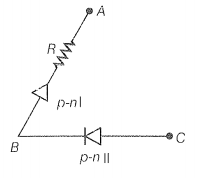Consider a box with three terminals on top of it as shown in figure.
Three components namely, two germanium diodes and one resistor are connected across these three terminals in some arrangement.
A student performs an experiment in which any two of these three terminals are connected in the circuit shown in figure.
The student obtains graphs of current-voltage characteristics for unknown combination of components between the two terminals connected in the circuit. The graphs are,
(i) when A is positive and B is negative
(ii) when A is negative and B is positive
(iii) when B is negative and C is positive
(iv) when B is positive and C is negative
(v) when A is positive and C is negative
(vi) when A is negative and C is positive
From these graphs of current-voltage characteristic shown in fig. (c) to (h), determine the arrangement of components between A, B and C.


© 2026 GoodEd Technologies Pvt. Ltd.






